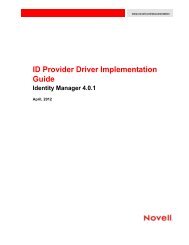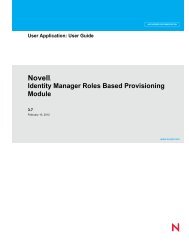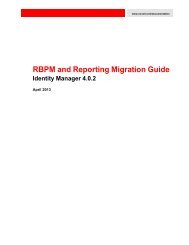Identity Manager 4.0.1 Driver for Scripting Implementation ... - NetIQ
Identity Manager 4.0.1 Driver for Scripting Implementation ... - NetIQ
Identity Manager 4.0.1 Driver for Scripting Implementation ... - NetIQ
You also want an ePaper? Increase the reach of your titles
YUMPU automatically turns print PDFs into web optimized ePapers that Google loves.
3.2.5 Running Multiple Instances of the <strong>Driver</strong> (optional)<br />
Running multiple instances of the Windows <strong>Scripting</strong> <strong>Driver</strong> on the same system may benefit<br />
per<strong>for</strong>mance. The instructions in this section assume that you have already installed the Windows<br />
<strong>Scripting</strong> <strong>Driver</strong> to the system.<br />
Adding an Instance<br />
To add an instance:<br />
1 Copy existing files:<br />
After stopping your original driver, create a new directory, and copy all original driver files to<br />
the new directory, using the same directory structure.<br />
For example, copy files and directories from C:\Program Files\Novell\WS<strong>Driver</strong> to<br />
C:\Program Files\Novell\WS<strong>Driver</strong>2.<br />
2 Edit wsdrv.conf:<br />
2a Open the file conf\wsdrv.conf in your new directory structure. Replace all file paths<br />
with the path to the new instance directory.<br />
For example, paths may appear <strong>for</strong> the -path, -tracefile and -connection options.<br />
2b Change the port numbers (connection and HTTP) to be different from the original driver's<br />
port numbers.<br />
For example, if the original driver uses default ports 8090 and 8091, the new instance<br />
could use 9090 and 9091. Note that these ports need to be opened in a firewall.<br />
3 Create a new service:<br />
Using the Command Prompt, run wsdriver.exe from the new instance directory with the<br />
following options:<br />
wsdriver -installService -instance {number} -path {path}<br />
The instance number could be 2 <strong>for</strong> the second instance, 3 <strong>for</strong> a third, and so on. The path<br />
should be the path to the new instance directory, using quote marks. Here's an example:<br />
wsdriver -installService -instance 2 -path "C:\Program<br />
Files\Novell\WS<strong>Driver</strong>2"<br />
This command will create a service named Novell IDM Windows Script <strong>Driver</strong> - 2.<br />
NOTE: If you would like to run a driver instance directly (not as a service), use the -instance<br />
option:<br />
wsdriver -instance 2<br />
This option is not needed <strong>for</strong> the original instance.<br />
4 Create a new driver object:<br />
4a Using i<strong>Manager</strong>, create a new IDM <strong>Driver</strong> to connect to the new instance. Alternatively,<br />
export the original driver's configuration and import it as a new driver.<br />
4b After creating the <strong>Driver</strong>, open its configuration. Change the port number in Remote<br />
Loader Connection Parameters to the new instance's connection port.<br />
5 Start the services and drivers:<br />
Start the server <strong>for</strong> the original and new instances, and start the <strong>Driver</strong>s in i<strong>Manager</strong>. The<br />
instances will run independently.<br />
Installing the <strong>Scripting</strong> <strong>Driver</strong> 23
















